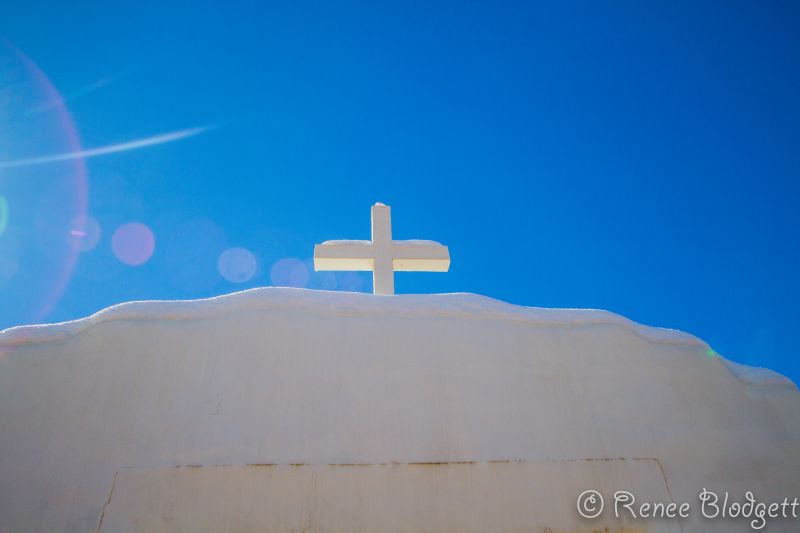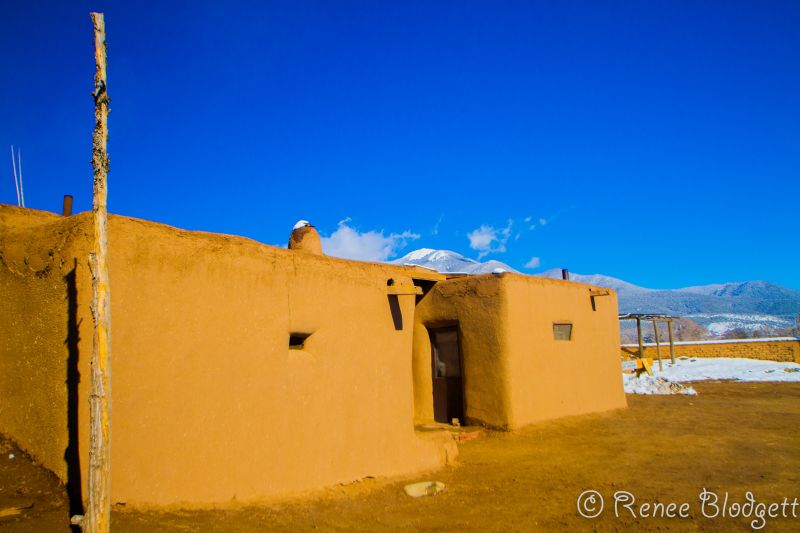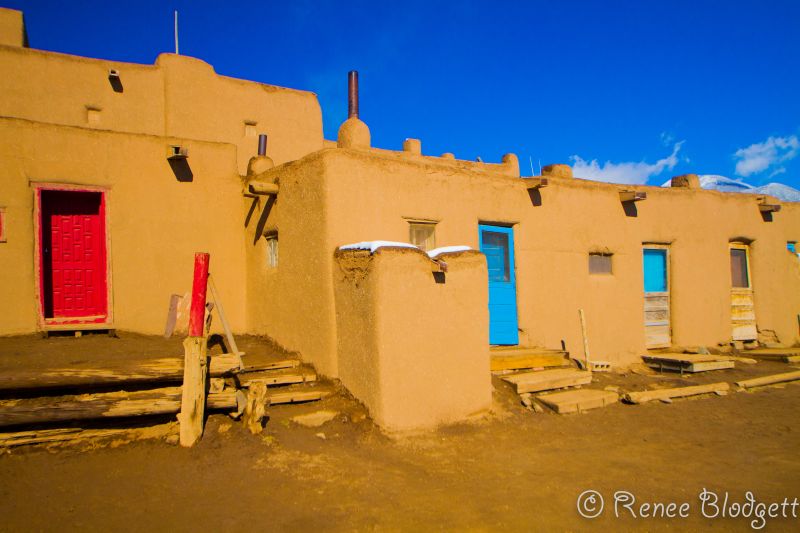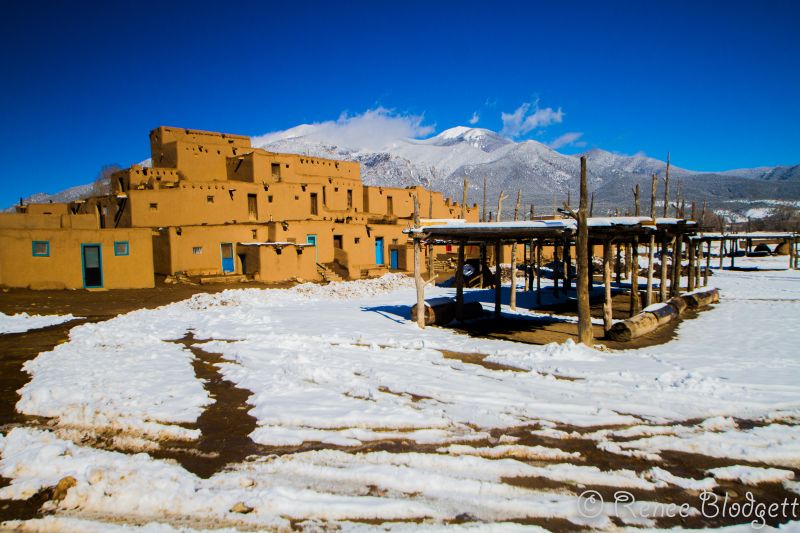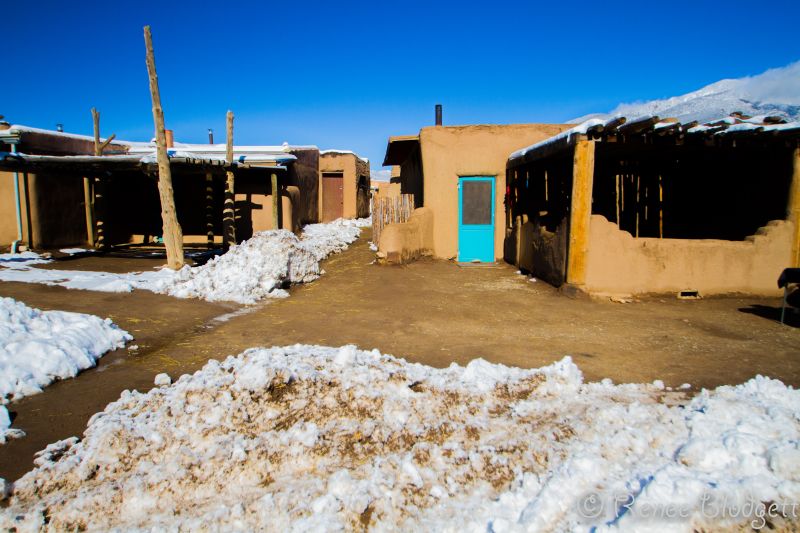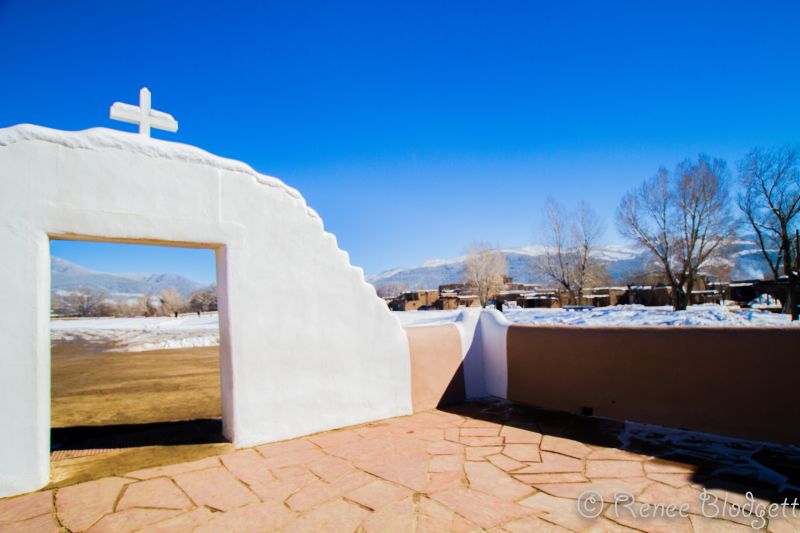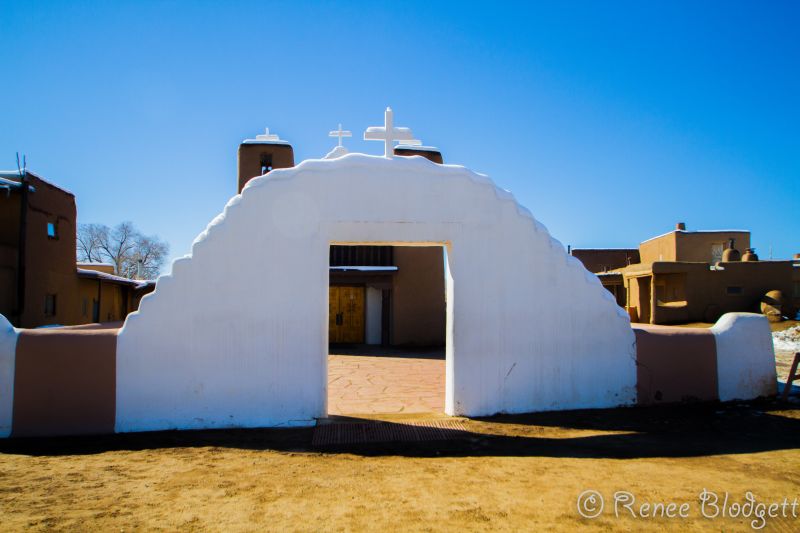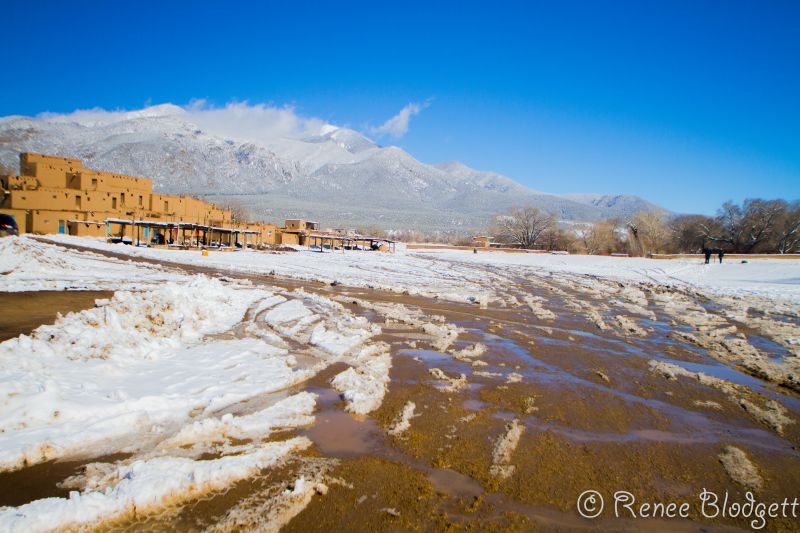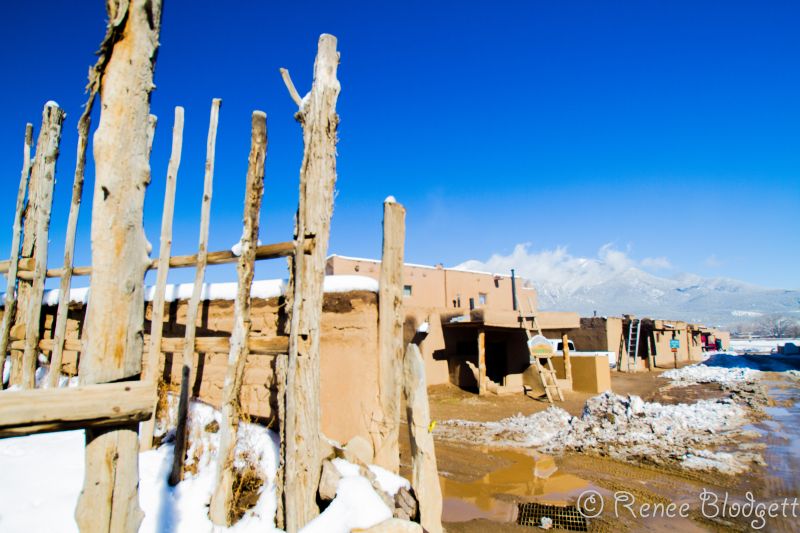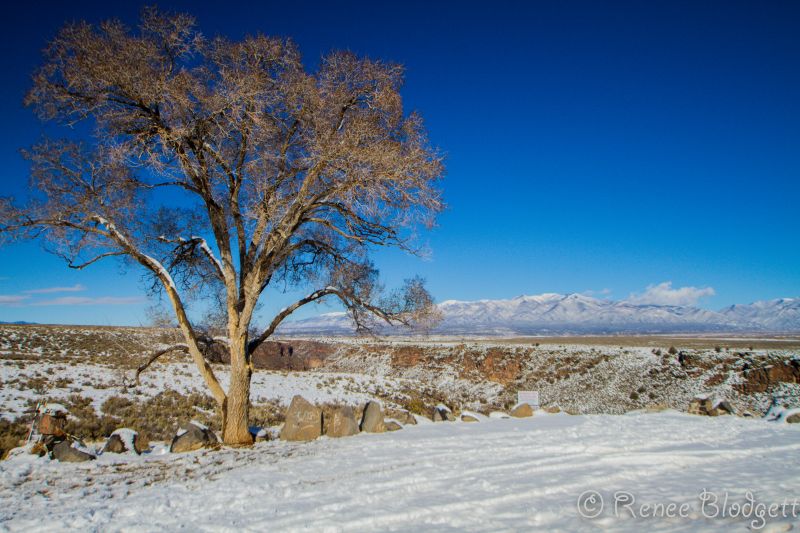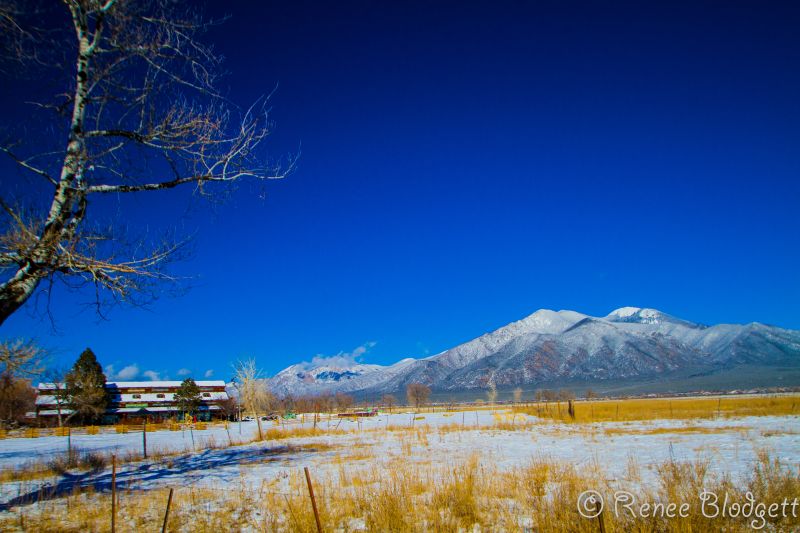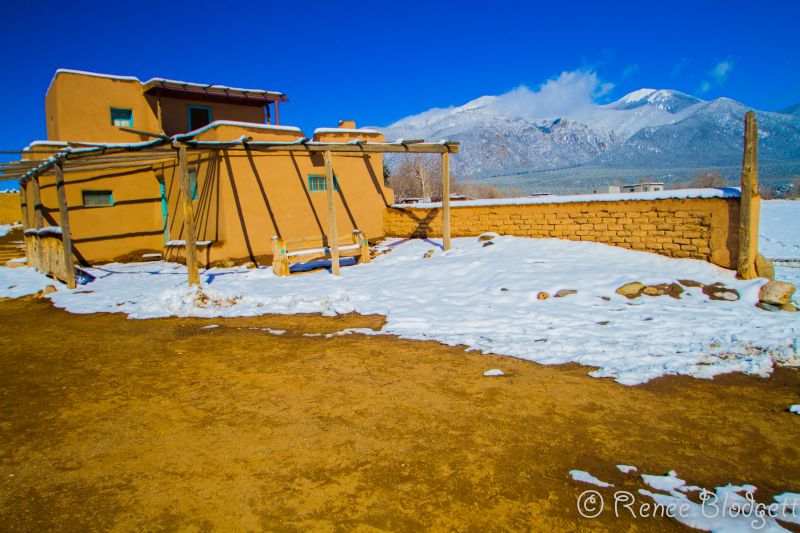When you arrive in Taos New Mexico, the name Taos Pueblo comes up in conversation regardless of who you talk to — once they realize you’re new to the area or a visitor passing through, you’re pointed to this ancient pueblo belonging to a Tewa-speaking Native American tribe of Puebloan people which lies about a mile north of the city of Taos itself. It is considered to be the oldest continuously inhabited community in America.
Situated in the valley of a small tributary of the Rio Grande, this adobe settlement – consisting of dwellings and ceremonial buildings – represents the culture of the Pueblo Indians of Arizona and New Mexico. Given its authenticity, history and age, among other things, it has become a UNESCO World Heritage Site and is one of a group of settlements established in the late 13th and early 14th centuries.
A little digging tells me that Taos Pueblo or otherwise referred to as Pueblo de Taos is similar to the settlements in the Four Corners area of the Anasazi, or ancient Pueblo people at such places as Chaco Canyon and Mesa Verde, and today, continues to be a thriving community with a living culture.
The architecture is so pure, you feel its raw antiquity as you walk onto the UNESCO site’s grounds. When we first arrived, it had been snowing for a couple of days, so was closed on one occasion because it was so muddy, so we had to return the following day. Pueblo de Taos is a remarkable example of a traditional type of architectural ensemble from the prehispanic period of the Americas at that time, but what’s even more remarkable is that it has successfully retained most of its traditional forms up to the current time.
Taos Pueblo shows the traditional method of adobe construction and because you can walk around the grounds freely, you can get up close and marvel at its design and staying power.
The pueblo consists of two clusters of houses, each built from sun-dried mud brick, with walls ranging from 70 cm thick at the bottom to about 35 cm at the top. Each year the walls are still refinished with a new coat of adobe plaster as part of a village ceremony. The rooms are stepped back so that the roofs of the lower units form terraces for those above.
The exteriors are plastered annually with adobe due to the exposure of the four seasons and even today, the Pueblo maintains a restriction of no electricity and running water within the sacred village. While some families adopted wood stoves for cooking, some continue to use the fireplace.
The units at ground level and some of those above are entered by doors that originally were quite small and low; access to the upper units is by ladders through holes in the roof. The living quarters are on the top and outside, while the rooms deep within the structure were used grain storage. The roofs are made from cedar logs, their ends protruding through the walls; on the logs are mats of branches on which are laid grasses covered with a thick layer of mud and a finishing coat of adobe plaster.
The multi-tiered adobe dwellings still retain their original form and outline, but details have changed. Doors, which traditionally were mostly used to interconnect rooms, are now common as exterior access to the ground floors and to the roof tops on upper stories. Windows, which traditionally were small and incorporated into walls very sparingly, are now common features. Taos remains the best preserved of the pueblos north of the Arizona and New Mexico borders.
While it is very quiet as you walk through the grounds (there were only one or two others from what we could tell when we were there), there are locals who either grew up in the Pueblo itself or have a connection to it. One girl spent some of her childhood there and while she now lives elsewhere, she returns to help family members sell artisan crafts they have made on the grounds. Another man has unique objects for sell inside a small adobe building, so small we had to duck our heads to enter it. Incense was burning and original Indian artifacts were among the beautiful earthenware made by the local people.
There’s a church outside (below), which jumped out of the bright blue sky like a snowball against a firey rage. Inside, we weren’t permitted to take photos and so we didn’t, but it was basic in design, but very meditative and calming, regardless of what religion you hail from, or….none at all. Fine carved wooden beams or Vigas greet you, as does a choir loft and the central altar figure of Virgin Mary, which along with other Santos, were brought by early Spanish missionaries.
The Virgin Mary within the native religion depicts the parallel of Mother Nature and the natives incorporated their values into the altar to be reminded of cultural values. On the right, there’s a symbolic casket, which were placed in missions throughout the new World to convert natives to Catholic funeral practices.
The San Geronimo Church built in 1850 is obviously not the original, but it is a Registered National Historic Landmark, and yet is one of the youngest buildings in the village. Today, roughly three quarters of the population practice some form of Catholicism, while the native rituals preserve 100% in daily life.
We met another man in his forties (my best guestimate), who was selling jewelry he made, laid out on a wooden table, carefully curated by color and style. His collection was by far, the best handmade and authentic jewelry we had seen at a fair price since we hit New Mexico. The prices have been soaring in recent years and are more in line today with Sedona than my recollection of the tourism trade from my last visit. Quite simply, we liked him….a lot and his work was beautiful, so purchased a few things.
We chatted a bit about his culture and while they don’t encourage you to take photos of people on the ground, he said some people are fine with it as long as you politely ask. I didn’t. The memory remains with his jewelry which I now wear regularly, and the beautiful adobe architecture of this ancient culture, which is thankfully still thriving today.
I realized as I walked through the establishment how fortunate I was to view such a historical and cultural landmark and the same sense of excitement soared through my body as did when I first saw something culturally foreign and new as a child. That excitement led me on a path to later study Anthropology and Sociology at university, which I sadly abandoned because I didn’t think I could make a healthy living in that field. And so now, today, I live in the world of technology — gadget, gear, mobile apps and EMF rays — a far cry from the pureness of cultural tribes and peoples I found my first passion in so many years ago.
Perhaps if I had followed that dream, I would have discovered something new for the first time or written a book that uncovered things perhaps only a small select group would be interested in hearing, but how is that different than the small select group of people in my so called “technology tribe” now, I thought? I mean, after all – my sister didn’t know who Apple founder Steve Jobs was when I raised his name and yet we pretend all too often that our industry is more important or relevant than another.
In this world, the world of modern Indians, some of whom still live in adobe houses in rural areas, are focused on their families, their art and crafts and eat from the earth, not from processed boxes that are slowly killing so many Americans today. While no doubt, many have fled this traditional establishment, one deeply rooted in so much history and culture, to find jobs in cities, many return, if not to live, to get reconnected to their culture and what that culture means, to them, and to their society as a whole.
Tiwa is their native language, which is unwritten and unrecorded and will remain so, but is passed down from generation-to-generation. I was curious how much it had changed as cultural norms change, nuances are added or English influences have impacted it, or….perhaps not. The shifting of times is evident but it is clear that they will not be a lost culture given their powerful attempt to keep traditions alive. If you had a heritage that started with views like this, wouldn’t you been keen to stay put in more ways than one?
Built around 1619 by Spanish priests and Indians, the cemetery on the grounds now stands where the original San Geronimo Church once stood. Drying racks are scattered throughout – today, they are still used to dry wild game meat for jerky, a favorite thing of mine about New Mexico in general. Jerky made in New Mexico seems to taste better somehow than other parts of the country, likely because of the dry heat necessary for optimal results. Natives also dried corn, pumpkin, squash, berries and bean crops.
If you believe in tradition, are curious about other cultures other than your own and love history, you’ll be deeply touched by the Taos Pueblo, a must stop during your Taos and surrounding area visit.
Details:
Taos Pueblo aka Pueblo de Taos
120 Veterans Highway
Taos, NM 87571
(575) 758-1028

Renee Blodgett is the founder of We Blog the World. The site combines the magic of an online culture and travel magazine with a global blog network and has contributors from every continent in the world. Having lived in 10 countries and explored nearly 80, she is an avid traveler, and a lover, observer and participant in cultural diversity.
She is also the CEO and founder of Magic Sauce Media, a new media services consultancy focused on viral marketing, social media, branding, events and PR. For over 20 years, she has helped companies from 12 countries get traction in the market. Known for her global and organic approach to product and corporate launches, Renee practices what she pitches and as an active user of social media, she helps clients navigate digital waters from around the world. Renee has been blogging for over 16 years and regularly writes on her personal blog Down the Avenue, Huffington Post, BlogHer, We Blog the World and other sites. She was ranked #12 Social Media Influencer by Forbes Magazine and is listed as a new media influencer and game changer on various sites and books on the new media revolution. In 2013, she was listed as the 6th most influential woman in social media by Forbes Magazine on a Top 20 List.
Her passion for art, storytelling and photography led to the launch of Magic Sauce Photography, which is a visual extension of her writing, the result of which has led to producing six photo books: Galapagos Islands, London, South Africa, Rome, Urbanization and Ecuador.
Renee is also the co-founder of Traveling Geeks, an initiative that brings entrepreneurs, thought leaders, bloggers, creators, curators and influencers to other countries to share and learn from peers, governments, corporations, and the general public in order to educate, share, evaluate, and promote innovative technologies.

